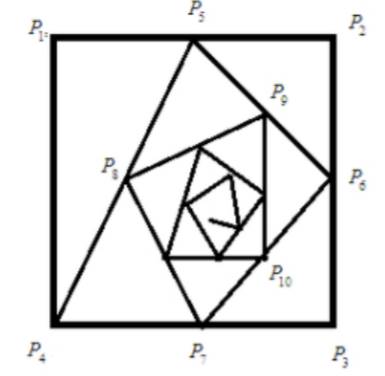
Concept explainers
(a)
To show: That 12xn+xn+1+xn+2+xn+3=2 , and find a similar equation for the y -coordinates.
(a)
Answer to Problem 12P
It is proved that 12xn+xn+1+xn+2+xn+3=2 , and similar equation in terms of y is 12yn+yn+1+yn+2+yn+3=32 .
Explanation of Solution
Given:
The vertices of the square are P1(0,1) , P2(1,1) , P3(1,0) , and P4(0,0) .
Calculation:
Draw the diagram as follows.

Pn(xn,yn) is the midpoint of Pn−4 and Pn−3 . So, xn=12(xn−4+xn−3) for n≥5 .
Use the induction on n , to prove the result.
Let n=1 ,
Substitute n=1 in the equation 12xn+xn+1+xn+2+xn+3=2 .
12x1+x1+1+x1+2+x1+3=212x1+x2+x3+x4=212(0)+(1)+(1)+(0)=22=2 (True)
Assume the result is true for n=k−1 .
12xk−1+xk−1+1+xk−1+2+xk−1+3=212xk−1+xk+xk+1+xk+2=2
Assume the result is true for n=k .
12xk+xk+1+xk+2+xk+3=2
Since Pk+3(xk+3,yk+3) is the midpoint of Pk+3−4 , and Pk+3−3 .
12xk+xk+1+xk+2+12(xk+3−4+xk+3−3)=212xk+xk+1+xk+2+12(xk−1+xk)=212xk−1+xk+xk+1+xk+2=2
Since the result is true for n=k−1 .
12xk−1+xk+xk+1+xk+2=22=2
Therefore, by the induction, the result 12xn+xn+1+xn+2+xn+3=2 is true for all n .
Pn(xn,yn) is the midpoint of Pn−4 and Pn−3 . So, yn=12(yn−4+yn−3) for n≥5 .
Consider 12yn+yn+1+yn+2+yn+3 .
Let n=1 ,
Substitute n=1 in the equation 12yn+yn+1+yn+2+yn+3 .
12yn+yn+1+yn+2+yn+3=12y1+y1+1+y1+2+y1+3=12y1+y2+y3+y4=12(1)+(1)+(0)+(0)=32
Assume the result is true for n=k−1 .
Substitute n=k−1 in the equation 12yn+yn+1+yn+2+yn+3 .
12yk−1+yk+yk+1+yk+2=32
Assume the result is true for n=k .
Substitute n=k in the equation 12yn+yn+1+yn+2+yn+3 .
12yk+yk+1+yk+2+yk+3=32
Since Pk+3(xk+3,yk+3) is the midpoint of Pk+3−4 , and Pk+3−3 .
12yk+yk+1+yk+2+12(yk+3−4+yk+3−3)=3212yk+yk+1+yk+2+12(yk−1+yk)=3212yk−1+yk+yk+1+yk+2=32
Since the result is true for n=k−1 .
12yk−1+yk+yk+1+yk+2=3232=32
Therefore, by the induction, the result 12yn+yn+1+yn+2+yn+3=32 is true for all n .
Therefore, it is proved that 12xn+xn+1+xn+2+xn+3=2 , and similar equation in terms of y is 12yn+yn+1+yn+2+yn+3=32 .
(b)
To find: The coordinate of P .
(b)
Answer to Problem 12P
The point P is (47, 37) .
Explanation of Solution
Given:
The vertices of the square are P1(0,1) , P2(1,1) , P3(1,0) , and P4(0,0) .
Calculation:
To find the x coordinate for P , take the limit tends to infinity for the relation 12xn+xn+1+xn+2+xn+3=2 .
limn→∞(12xn+xn+1+xn+2+xn+3)=limn→∞(2)limn→∞(12xn)+limn→∞(xn+1)+limn→∞(xn+2)+limn→∞(xn+3)=limn→∞(2)12limn→∞(xn)+limn→∞(xn+1)+limn→∞(xn+2)+limn→∞(xn+3)=2
Since the values of the above all limits are equal.
12limn→∞(xn)+limn→∞(xn)+limn→∞(xn)+limn→∞(xn)=2limn→∞(xn)(12+1+1+1)=272limn→∞(xn)=2limn→∞(xn)=47
To find the y coordinate for P , take the limit tends to infinity for the relation 12yn+yn+1+yn+2+yn+3=32 .
limn→∞(12yn+yn+1+yn+2+yn+3)=limn→∞(32)limn→∞(12yn)+limn→∞(yn+1)+limn→∞(yn+2)+limn→∞(yn+3)=limn→∞(32)12limn→∞(yn)+limn→∞(yn+1)+limn→∞(yn+2)+limn→∞(yn+3)=32
Since the values of the above all limits are equal.
12limn→∞(yn)+limn→∞(yn)+limn→∞(yn)+limn→∞(yn)=32limn→∞(yn)(12+1+1+1)=3272limn→∞(xn)=32limn→∞(yn)=37
Therefore, the point P is (47, 37) .
Chapter 8 Solutions
Single Variable Calculus: Concepts and Contexts, Enhanced Edition
- Use the properties of logarithms, given that In(2) = 0.6931 and In(3) = 1.0986, to approximate the logarithm. Use a calculator to confirm your approximations. (Round your answers to four decimal places.) (a) In(0.75) (b) In(24) (c) In(18) 1 (d) In ≈ 2 72arrow_forwardFind the indefinite integral. (Remember the constant of integration.) √tan(8x) tan(8x) sec²(8x) dxarrow_forwardFind the indefinite integral by making a change of variables. (Remember the constant of integration.) √(x+4) 4)√6-x dxarrow_forward
- a -> f(x) = f(x) = [x] show that whether f is continuous function or not(by using theorem) Muslim_mathsarrow_forwardUse Green's Theorem to evaluate F. dr, where F = (√+4y, 2x + √√) and C consists of the arc of the curve y = 4x - x² from (0,0) to (4,0) and the line segment from (4,0) to (0,0).arrow_forwardEvaluate F. dr where F(x, y, z) = (2yz cos(xyz), 2xzcos(xyz), 2xy cos(xyz)) and C is the line π 1 1 segment starting at the point (8, ' and ending at the point (3, 2 3'6arrow_forward
- I need help in ensuring that I explain it propleryy in the simplifest way as possiblearrow_forwardI need help making sure that I explain this part accutartly.arrow_forwardPlease help me with this question as I want to know how can I perform the partial fraction decompostion on this alebgric equation to find the time-domain of y(t)arrow_forward
 Calculus: Early TranscendentalsCalculusISBN:9781285741550Author:James StewartPublisher:Cengage Learning
Calculus: Early TranscendentalsCalculusISBN:9781285741550Author:James StewartPublisher:Cengage Learning Thomas' Calculus (14th Edition)CalculusISBN:9780134438986Author:Joel R. Hass, Christopher E. Heil, Maurice D. WeirPublisher:PEARSON
Thomas' Calculus (14th Edition)CalculusISBN:9780134438986Author:Joel R. Hass, Christopher E. Heil, Maurice D. WeirPublisher:PEARSON Calculus: Early Transcendentals (3rd Edition)CalculusISBN:9780134763644Author:William L. Briggs, Lyle Cochran, Bernard Gillett, Eric SchulzPublisher:PEARSON
Calculus: Early Transcendentals (3rd Edition)CalculusISBN:9780134763644Author:William L. Briggs, Lyle Cochran, Bernard Gillett, Eric SchulzPublisher:PEARSON Calculus: Early TranscendentalsCalculusISBN:9781319050740Author:Jon Rogawski, Colin Adams, Robert FranzosaPublisher:W. H. Freeman
Calculus: Early TranscendentalsCalculusISBN:9781319050740Author:Jon Rogawski, Colin Adams, Robert FranzosaPublisher:W. H. Freeman
 Calculus: Early Transcendental FunctionsCalculusISBN:9781337552516Author:Ron Larson, Bruce H. EdwardsPublisher:Cengage Learning
Calculus: Early Transcendental FunctionsCalculusISBN:9781337552516Author:Ron Larson, Bruce H. EdwardsPublisher:Cengage Learning





